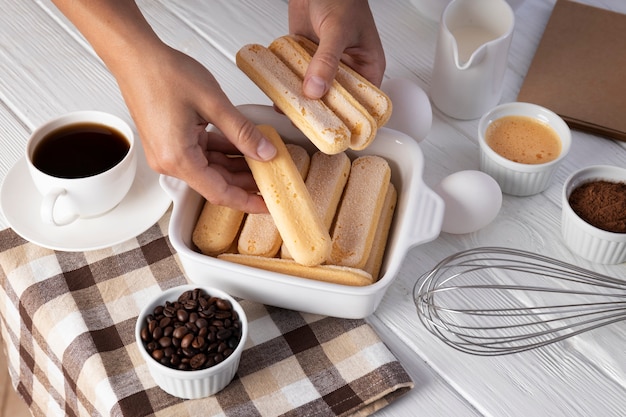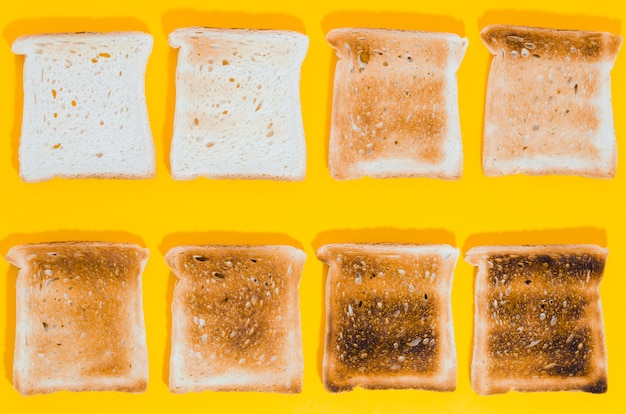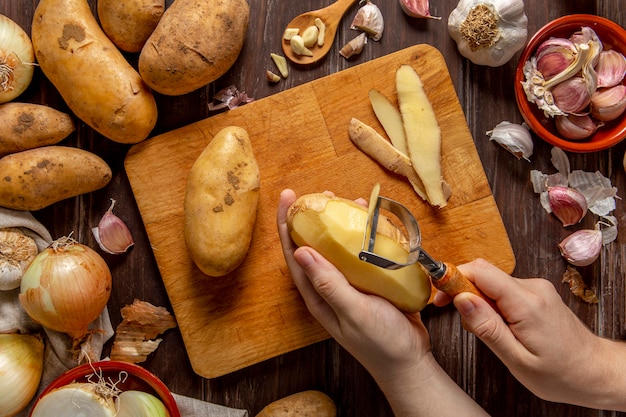Ah, garlic bread. It’s the side dish that makes every meal feel a bit more special, whether it’s a simple weeknight dinner or a grand feast. But let's be honest, achieving that golden-brown, garlicky perfection can be a bit of a culinary puzzle. You don’t want it burnt to a crisp, but you also don’t want it undercooked and doughy. So, how long do you actually cook it for? Well, I’m here to share my experience and help you navigate the garlic bread baking time labyrinth!
(Part 1) The Secret to Success: Understanding Garlic Bread

I’ve been baking garlic bread for years, and I've learned that the key to success lies in understanding the basics. It’s not just about throwing some garlic butter on a loaf and popping it in the oven. It's about getting the right balance of heat, time, and, of course, the magic ingredient: garlic! Think of it like a culinary equation: you need to get all the variables right to get that perfect result.
The Power of the Loaf: Choosing the Right Foundation
Let’s start with the bread itself. The kind of bread you choose has a huge impact on baking time. A thick, rustic loaf will take longer to cook through than a thin, baguette-style bread. It’s like building a house; you need a sturdy foundation, and in this case, the bread is our foundation. Imagine trying to bake a thick, dense sourdough loaf in the same amount of time as a thin, airy baguette – it’s just not going to work! And don't forget about the size! A smaller loaf will obviously bake faster than a giant one. Just like a smaller house takes less time to build.
Garlic Butter: The Flavor Bomb
Then, there’s the garlic butter. You want to make sure you've got the right amount of garlic for your taste and enough butter to coat the bread generously. It’s all about finding the right balance. If you go too heavy on the garlic, you’ll end up with a flavour that’s a bit too strong, like a symphony with too much bass. And if you skimp on the butter, your bread might dry out, like a desert landscape lacking moisture.
Oven Temperatures: The Heat Factor
And finally, we have the oven temperature. This is crucial for achieving that perfect golden-brown colour and ensuring the bread cooks evenly. A higher temperature will cook the bread faster, while a lower temperature will result in a slower, more gentle bake. Think of it like cooking over a high flame versus a simmer. A high flame will sear quickly, while a simmer will allow the flavors to develop slowly.
(Part 2) Setting the Stage: Oven and Bread Prep

Now, let’s get down to business. Before you even think about throwing your garlic bread into the oven, there are a few essential steps you need to take. These steps will set you up for success and ensure that your garlic bread turns out deliciously perfect.
Preheat Your Oven: The Golden Rule
Firstly, preheating your oven is absolutely crucial. It’s like getting your kitchen ready for a culinary masterpiece. A preheated oven allows the bread to cook evenly and prevents it from becoming soggy. I usually preheat my oven to 190°C (375°F) – but, as we'll see, the exact temperature can vary depending on your oven and the type of garlic bread you're making. Imagine starting to cook without a preheated pan – you wouldn’t get the same results, would you?
Prepare the Bread: Slice and Spread
Next, it's time to prepare the bread. If you're using a loaf, slice it all the way through, but not completely, leaving the bottom piece intact. This will allow the garlic butter to seep into every nook and cranny. Then, generously spread your garlic butter mixture onto each slice. Remember, there's no such thing as too much garlic butter when it comes to garlic bread! Think of it as a delicious paintbrush, covering the canvas of your bread.
Get Creative with Toppings: Taking It to the Next Level
Now for the fun part: toppings! While garlic bread is delicious on its own, you can always elevate it to new heights with some creative additions. A sprinkle of Parmesan cheese adds a salty, umami flavour, while some chopped fresh herbs like parsley or oregano provide a touch of freshness. And if you're feeling adventurous, you can even try adding some crushed red pepper flakes for a bit of heat. These toppings are like the finishing touches on a painting – they add depth and complexity.
(Part 3) The Big Bake: Baking Times and Techniques

Alright, the moment of truth is here. You've prepped your bread, you've got your oven nice and hot, and you're ready to bake. But before you just toss it in there, let’s talk about the specific baking times and techniques for different types of garlic bread.
Classic Garlic Bread: Simple and Delicious
If you're going for a classic garlic bread, you'll want to bake it for about 10-15 minutes. Keep an eye on it, though, and be ready to pull it out of the oven when it starts to turn golden brown. You'll know it's done when the garlic butter is bubbly and the bread is firm to the touch. It's like a culinary dance, where you observe, react, and achieve that perfect balance.
Classic Garlic Bread Baking Times Table
Here's a handy table to give you an idea of the baking times for different bread types:
| Bread Type | Baking Time |
|---|---|
| Baguette | 10-15 minutes |
| Sourdough | 15-20 minutes |
| Ciabatta | 12-18 minutes |
Garlic Bread Pizza: The Best of Both Worlds
If you're feeling adventurous, you can even make a garlic bread pizza! This is basically a pizza crust made from garlic bread. It's a fun way to put your own spin on the classic garlic bread recipe. To make a garlic bread pizza, you'll need to bake the garlic bread for about 8-10 minutes, then remove it from the oven and add your favourite pizza toppings. Return it to the oven and bake for another 5-7 minutes, or until the cheese is melted and bubbly. The baking times will depend on the thickness of the bread and the type of toppings you choose. It's like a culinary fusion, combining two classic dishes into one delicious creation.
Garlic Bread Sticks: A Light and Crispy Treat
For a lighter and crispier treat, try making garlic bread sticks. These are perfect for dipping in your favourite sauce or enjoying as a snack. You'll need to bake the garlic bread sticks for about 10-12 minutes, or until they're golden brown and crispy. They're like the little culinary gems of the garlic bread world, offering a delightful bite-sized experience.
(Part 4) The Art of Patience: Checking for Doneness
Now, you've got your garlic bread in the oven, but how do you know when it's actually done? This is where your senses come into play. Don't just rely on a timer - take a peek and use your sight, smell, and even your touch to check for doneness. It's like a culinary detective work, using all your senses to unravel the mystery of perfect garlic bread.
Golden-Brown Perfection: The Visual Cue
The first sign that your garlic bread is getting close is when the top starts to turn a beautiful golden brown. It's like watching a masterpiece come to life. The colour should be evenly distributed, with no dark spots or areas that are still pale. It's like a golden sunset, painting the sky with hues of perfection.
Bubbly Butter: The Smell Test
Next, give it a sniff. You should be able to smell that delicious garlic butter aroma wafting through the air. If the smell is weak or the butter isn't bubbling, it might need a few more minutes in the oven. It's like the scent of a freshly baked loaf, inviting you to take a closer look.
Firm to the Touch: The Touch Test
Finally, give the bread a gentle press with your finger. It should feel firm and slightly springy, not soft and doughy. If it feels undercooked, put it back in the oven for a few more minutes. It's like testing the ripeness of a fruit, where a gentle touch reveals its readiness.
(Part 5) The Final Touch: Serving and Storing
Your garlic bread is now cooked to perfection! But before you dive in, take a moment to admire your creation. It should have that beautiful golden-brown hue, be fragrant with garlic, and have a firm texture. Now, it's time to serve and store your garlic bread so that it remains delicious. It's like presenting a work of art, showcasing its beauty and ensuring its longevity.
Serving with Style: A Culinary Presentation
To serve your garlic bread, you can simply slice it and place it on a platter. Or, you can get a bit more creative and arrange it on a bed of fresh arugula or spinach. A drizzle of olive oil and a sprinkle of Parmesan cheese will also add a touch of sophistication. It’s like creating a culinary tableau, where the garlic bread takes center stage.
Storing for Later: Maintaining Freshness
If you have leftover garlic bread, you can store it in an airtight container at room temperature for up to 2 days. For longer storage, you can wrap it tightly in plastic wrap and store it in the freezer for up to 3 months. To reheat frozen garlic bread, simply place it in a preheated oven at 175°C (350°F) for 5-7 minutes, or until heated through. It's like preserving a culinary treasure, ensuring its enjoyment for days or even months.
(Part 6) The Art of Experimentation: Beyond the Basics
Garlic bread is a blank canvas, waiting for you to add your own personal touch. Don't be afraid to experiment with different flavours and toppings. You can add a sprinkle of herbs, some chopped nuts, or even a few slices of bacon. Get creative and have fun with it! I've found that adding a touch of chili flakes to my garlic butter creates a bit of heat that pairs well with creamy cheeses and meats. It's like a culinary adventure, where you explore new flavors and textures.
Spice it Up: Adding Heat and Flavor
If you're a fan of spice, try adding some red pepper flakes to your garlic butter. Start with a small amount and adjust to taste. You can also add other spices like oregano, thyme, or rosemary to give your garlic bread a more complex flavour. It's like adding a dash of chili to your culinary symphony, bringing a touch of warmth and intrigue.
Cheese It Up: Elevating the Texture
Another way to elevate your garlic bread is by adding cheese. Mozzarella, Parmesan, and even Gruyere are all great choices. You can sprinkle the cheese on top of the bread before baking, or you can add it after baking for a melty, gooey texture. It's like layering textures, creating a symphony of cheese and bread.
Go Green: Adding Freshness
To add a touch of freshness to your garlic bread, you can sprinkle it with fresh herbs like parsley, oregano, or basil. These herbs will add a bright flavour that complements the garlic butter. It's like adding a sprig of green to your culinary bouquet, bringing a touch of freshness and vibrancy.
(Part 7) The Importance of the Oven: Understanding Variations
Every oven is different, and they all have their own quirks. Some ovens heat up faster, while others have hot spots. This can affect the baking time of your garlic bread. So, don't just blindly follow a recipe. Keep an eye on your bread and be prepared to adjust the baking time as needed. It's like learning to navigate a new terrain, understanding the unique characteristics of your oven to achieve perfect results.
Oven Temperature and Baking Time: Finding the Right Balance
If your oven tends to run hot, you might need to reduce the baking temperature slightly. On the other hand, if your oven tends to run cool, you might need to increase the baking time. It's all about finding the right balance to ensure your garlic bread is cooked to perfection. It's like finding the sweet spot between heat and time, achieving a perfect harmony.
Don't Be Afraid to Adjust: Your Oven, Your Rules
Don't be afraid to experiment with different temperatures and baking times. The key is to pay attention to your bread and use your senses to determine when it's done. There's no one-size-fits-all answer to the question of how long to bake garlic bread. It's a matter of trial and error and finding what works best for your oven. It's like mastering a culinary art, where practice and intuition are key.
(Part 8) FAQs: Your Garlic Bread Baking Questions Answered
You've got questions. I've got answers! Here are some of the most frequently asked questions about garlic bread baking time and techniques.
1. What is the best temperature to bake garlic bread?
The best temperature to bake garlic bread is 190°C (375°F). This temperature will ensure that the bread cooks evenly and turns a beautiful golden brown. However, you may need to adjust the temperature slightly depending on your oven and the type of garlic bread you're making. It's like finding the ideal temperature for a perfect cup of tea – it's all about finding that perfect balance.
2. How can I prevent garlic bread from getting soggy?
To prevent garlic bread from getting soggy, it's important to preheat your oven to the correct temperature. Also, make sure that your bread is sliced all the way through, but not completely, so that the garlic butter can penetrate the bread. Finally, you can also use a baking sheet with a wire rack to allow air to circulate around the bread. It’s like creating a culinary environment that prevents moisture from accumulating and ensures a crispy, delicious result.
3. How do I know if garlic bread is done?
Garlic bread is done when it's golden brown, the garlic butter is bubbling, and the bread is firm to the touch. You can also give the bread a gentle press with your finger – it should feel firm and slightly springy, not soft and doughy. If it feels undercooked, put it back in the oven for a few more minutes. It's like a culinary dance, where you observe, react, and achieve that perfect balance.
4. How long can I store garlic bread?
You can store garlic bread in an airtight container at room temperature for up to 2 days. For longer storage, you can wrap it tightly in plastic wrap and store it in the freezer for up to 3 months. To reheat frozen garlic bread, simply place it in a preheated oven at 175°C (350°F) for 5-7 minutes, or until heated through. It’s like preserving a culinary treasure, ensuring its enjoyment for days or even months.
5. What are some creative ways to use garlic bread?
Garlic bread can be used in a variety of ways! You can use it as a base for a pizza, turn it into garlic bread sticks, or even use it as a side dish for pasta or soup. Get creative and see what you can come up with! One of my favourite ways to use leftover garlic bread is to cut it into cubes and add it to a salad for some added crunch and flavour. It's like a culinary chameleon, adapting to different dishes and adding a unique touch.
So there you have it! My guide to garlic bread baking time, a journey from the basics to creative variations. Remember, baking is about experimentation and finding what works best for you. So, get out there, grab your favourite loaf of bread, and get baking!
Everyone is watching

Corn on the Cob: The Ultimate Guide to Perfectly Cooked Ears
Healthy MealsAh, corn on the cob. Just the name evokes images of sunny days, barbecues, and that sweet, juicy flavour that ...

Scallops: The Ultimate Guide to Perfect Cooking
Healthy MealsAh, scallops. Those delicate, sweet, and utterly delicious morsels of the sea. They hold a special place in my...

Spaghetti Squash: The Ultimate Guide to Cooking and Serving
Healthy MealsRemember that time you saw spaghetti squash at the supermarket, looking all bumpy and strange, and thought, "W...

Salmon Cooking Times: Perfect Guide for Every Recipe
Healthy MealsLet me tell you, cooking salmon is an art form. It's all about getting that perfect balance: juicy and tender,...

Ham Cooking Time: How Long to Bake, Smoke, or Boil a Delicious Ham
Healthy MealsAh, ham. It's a classic, isn't it? A real crowd-pleaser, especially around holidays. And when done right, it'...
